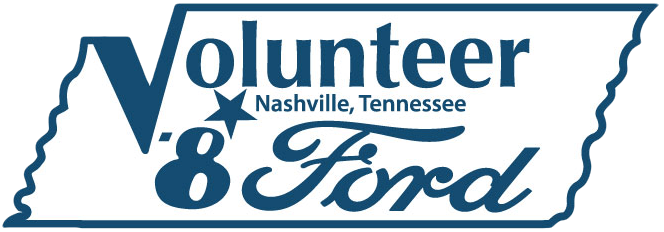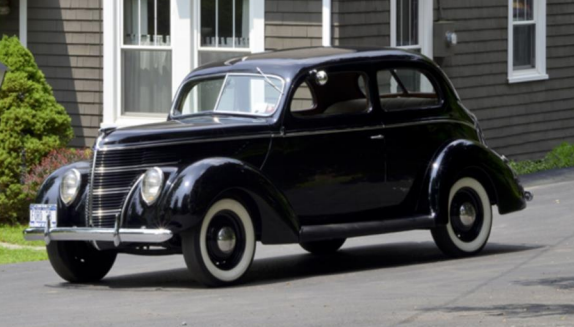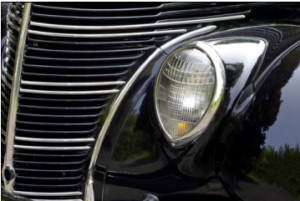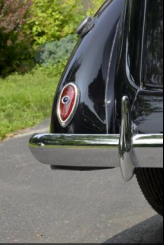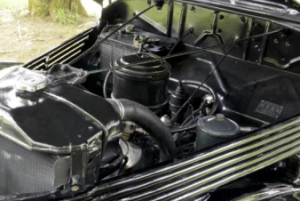A 1938 Ford Standard Lives the DeLuxe Life
A standard Ford and more!
Almost a half-century ago, Dave Barnes was in the right place at the right time when the right car showed up right in front of him. “In 1972,” said Barnes, whose 1938 Ford Standard Tudor is featured here, “I was teaching auto mechanics over at Delhi Tech and one of the guys who worked with me had a ’37 Ford and he was going to car shows. Well, I’d never thought about that. His car was pretty neat, dark blue and I liked that, so I was looking.”
He didn’t have to look far, as he was driving near his home in Oneonta, N.Y., when “a crazy story” began to unfold near a service station. “I looked up,” Barnes said, “and there was this ’38 Ford pulling over to the curb. A guy got out and came across and he said, ‘I just bought this from an estate. I have Model Ts. The thing quit.’ The service station owner didn’t want to monkey with it. I went across and I looked at it and I said, ‘You’re getting no spark.’” The owner of a nearby service station agreed that the Ford could be parked there,
and Barnes gave its driver a ride home.
After the car had cooled, removing the distributor “low” position became much easier and Barnes soon had the Ford running. He called the owner, who returned with his wife. “Well, she liked Model A Fords,” Barnes said, and
she hated that thing. She did not want it. She told him that, right in front of all of us. “He said, ‘How much do I owe you?’ I said, ‘I’ve got a question for you. You bought it from an estate and you bought a new battery. I’d like to own it.’ He said, ‘You would? Well, you heard my wife. Get me home, give me $1500
and it’s yours.’” While unfortunate for her husband, it was lucky for Barnes. The car was, after all, very much like the Ford owned by Barnes’ colleague and it’s not exactly a challenge to see its appeal. A short history with V-8s: Ford in 1938 was proud of the V-8 it had introduced just six years earlier as “the greatest thrill in motoring.” The Ford V-8 was “a great new motor
car” and if Chevrolet had claimed that its 1929 six cylinder was “everywhere regarded as marking an epoch in the development of luxurious transportation for everybody, every where,” it was now “not too much to say that
the new Ford is a revolutionary automobile, for it is a new motor car, made to meet today’s new conditions.” Naturally, the key was the V-8, a 221-cid flathead producing 65 hp, and Ford was able to state with a completely
straight face that its new engine “for the first time brings into the lowest price field the V8 type of engine.” It was “remarkably smooth in operation and … unusually quiet.” The bodies, though, were the other half of the new
Ford in 1932. The V-8 — as well as its fourcylinder stablemate, the Model B — maintained continuity with the Model A while updating the general look, but it lasted only a year.
The 1933 Ford was redesigned so that albut the faintest traces of boxiness were gone and after a gentle update for 1934, “every line and outward detail
of the 1935 Ford has been made to contribute its rightful share to the car’s pleasing personality.” The four was gone and “the space economizing V-8 engine” was moved even farther forward in the chassis. The entire
frame was redesigned for car bodies which would seat all the passengers farther forward. Another update followed for 1936 and things began to change in 1937. Enter the V-8 ’60.’ The new models were instantly recognizable
as Fords, continuing the trend away from the sharp, vertical styling of just a few years earlier, but something else was introduced in “the new Ford V-8 cars for 1937.” Advertising explained that “the Ford V-8 for 1937 is powered by a modern V-type, 8- cylinder engine. But this year, two sizes of this engine are offered — an improved 85-horsepower size for maximum performance and a new 60-horsepower size for maximum economy. It is still one car, one standard of size and comfort. With the smaller engine optional in several body types, a new low price is brought to the Ford line.” Ford didn’t merely de-tune the
85-hp V-8 to create the V-8 “60.” With nothing nearby to provide a sense of scale, the 136-cid V-8 “60” didn’t look much different than the 221-cid “85,” but
the reality was that “the engine in the new Ford ‘60’ is a V-8 through and through. It is almost exactly the same as the well-known 85-horsepower Ford
V-8 engine, except for size, weight and horsepower.” It was “optional in the 5-window coupe and in closed sedan types without DeLuxe equipment.” The part about models “without De Luxe equipment” hinted at what was ahead. Ford was on a two-year styling cycle, so the 1938 model was given a new
look. Unless it was a Standard. DeLuxe? Or Standard?
Advertising announced “the two new Ford V- 8 cars for 1938 … the Standard Ford V-8 and the De Luxe Ford V-8. People liked our 1937 cars so well that they bought more of them than of any other make. We have improved on that car in the newly styled Standard Ford V-8 for 1938. But some folks asked also for a
bigger, finer car with the same Ford advantages in it. For them, we designed the new De Luxe Ford V-8. The De Luxe sedans have longer bodies with more room and finer appointments. De Luxe cars are equipped with the 85-hp engine. They give added motoring satisfaction at low Ford prices. The Standard
is even lower priced than the De Luxe. It has pleasant new lines and well-tailored interiors. It offers again a choice of V-8 engine sizes: the powerful ‘85’ or the thrifty ’60.’” What’s less than clear in that text is that the 1938
Standard looked very, very much like the 1937 De Luxe. Ford would follow that pattern through 1940, but the first-year version explains why Barnes’ finding the feature car — a 1938 — was just about the same as finding one like the 1937 Ford owned by his friend.
It’s next to impossible to determine with certainty whether the rather basic nature of Barnes’ Ford played a role in its original sale, but what
he knows about its past does suggest a careful and perhaps frugal owner. Making an old Ford last “She never drove it in the winter,” Barnes said of the first owner. “In fact, she had wooden blocks made for her garage and
the Ford dealer here sent a mechanic up every fall and he’d jack that car up and he’d put the wooden blocks under it for her and set it back down.” That saved the Ford from the worst driving conditions that upstate New
York has to offer. Barnes said that the odometer showed about 48,000 miles when he bought it and besides paint, the body needed only minor work. “Hardly any,” he said. “One fender had a little scratch in it and we fixed
that up … Those fenders stick out and they were scratched up, but they were repairable.” A partial repaint seemed to suffice, but showing the car, he realized that new paint all around would be better appreciated. It was repainted once and after about 10 years, repainted again about 15 years ago. The Ford’s
interior was in about the same condition as the body and Barnes has worked on it only when absolutely necessary. “The inside could be redone,” he said, “but I like it. It’s still original. I had to put one patch on the seat and the
doors are a little rough and dirty, but I said, ‘You know, to me, that’s more what that car should look like.’”
All of the Ford’s trim was intact when he bought the car, an important point since the Standard’s trim is not identical to that on the 1937 De Luxe it mimics. “It’s harder to find,” Barnes said, “and I can’t understand why they’d make them different, but they did.” The Ford’s mechanical condition was a close match to that of the body. Barnes recalled that the engine — the ‘85’ in his Standard — “smoked like the devil” when he bought it. But he had a plan. “Working at Delhi Tech, teaching auto mechanics,” he explained, “ I took it over to the school and the kids yanked the engine out of it. We went through that engine to see why it
was smoking. She didn’t drive it that much, but the rings were all gummed up and they were seized right inside the piston, so they weren’t washing the oil off of the walls. “It was just ‘tear it down and put it back together.’ We put in new timing gears and rings and I think that was about it as far as the rebuild goes,
no new bearings. I had the crankshaft at a machine shop. They checked the crank out, polished it up and put all standard bearingsin.” The only other mechanical work that the Ford required was boiling out its radiator and
since the car went back on the road, it’s been almost trouble-free.
The sole exception to its otherwise perfect record was a fuel pump failure. Its longest trip has been about 75 miles, but Barnes said he has no reason to believe that it’s not ready for something more. Even from its relatively short
trips, he knows that it’s noticed and many who see it want a closer look. “People spot it all the time,” he said. “It stands out in the parking lot. Get out of it and they’ll come over. Most say ‘what year is it?’ They don’t know the year
exactly. They look it over and talk to me. It makes it interesting … You’ll hear them saying things back and forth to each other.
Someone’ll say his grandfather or uncle had a
Ford about that year.” And some will notice
that it’s a Standard. “Yeah,” Barnes said. “They look it over pretty good.” .
